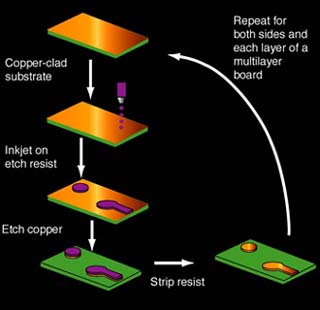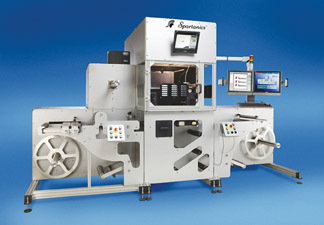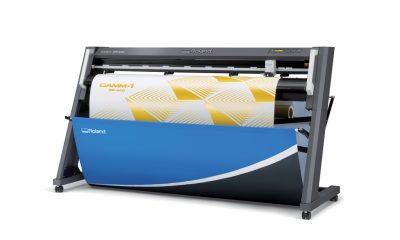Graphics Printing
Published
10 years agoon

Most film laminators (Figure 1) are so similar in purpose that choosing from the many options and models can be tough. Your best bet is to start by considering the laminator size. In general, it’s best to buy the widest laminator you can afford. A wide laminator will allow you to run narrower products side by side, improve throughput, prevent film waste, and grow into larger, more demanding applications. If space is a concern, some wide-format models feature conservative footprints and are ideal for tight production areas.
Most film laminators (Figure 1) are so similar in purpose that choosing from the many options and models can be tough. Your best bet is to start by considering the laminator size. In general, it’s best to buy the widest laminator you can afford. A wide laminator will allow you to run narrower products side by side, improve throughput, prevent film waste, and grow into larger, more demanding applications. If space is a concern, some wide-format models feature conservative footprints and are ideal for tight production areas. Here are some additional considerations:
Cold vs. thermal Choosing between thermal and cold laminating units is an important decision. A thermal unit can process cold laminates (those that adhere to the graphic substrate with a pressure-sensitive adhesive) and thermal laminates (those that feature a heat-activated adhesive), while a cold unit can only apply pressure-sensitive laminating materials.
Construction Open architecture is a must, especially when it comes to larger laminators used in high-volume production environments. Operators need to be able to replace web rolls of laminating film easily and access internal mechanisms, circuitry, and other parts.
Rollers Rollers are responsible for bringing the graphic material and laminate into contact with one another, so selecting the most effective type is essential for consistent, high-quality results. Wide-format laminators, because of their size, are sometimes prone to problems in applying adequate pressure across the entire width of the products that pass through them. Here, straight rollers facilitate uniform contact, even at very light nip pressures, while crowned roller make contact in the center of the rolls before making contact across the roll face.
Heat sources and cooling Most thermal laminators rely on a suspended heat source that runs through the nip rollers. The heater’s duty cycle involves bringing itself up to operating temperatures, heating the surrounding ambient air, and maintaining those temperatures. Contact heat sources actually touch the inside surface of the roller assemblies and are, therefore, designed to provide faster thermal-recovery rates and consistent temperature across the roll face.
Thermal laminators generally feature a cooling apparatus between the pull rollers—they’re responsible for maintaining proper film tension and guiding the laminating process—and the laminating nip rollers. The cooling mechanism typically takes the form of chill rollers that pull excessive heat out of film and cool it to a flat state. The chill rollers are not internally cooled, but instead rely on a fan bank or group of blowers to help them dissipate heat.
Controls and adjustability Options range from simple analog systems with mechanical switches to advanced, digitally driven systems with touchpad controls and digital readouts.
Speed Throughput is always a concern in a graphics shop, but running laminators at slower speeds often gives a higher guaranteed success rate of throughput and gives operators time to focus on more efficient ways to trim prints after they exit the laminator. Running a laminator too fast brings the risk of wrinkling, and high speeds will prevent proper bonding if too little pressure and heat are applied.
Safety features Physical hand guards are essential and must be difficult to defeat. Some guards feature lay-down strips that help keep prints flat. Electronic eyes sound an alarm when an operator comes too close to the nip assembly. Emergency stops (e-stops) are also critical and should be easily accessible on all four sides of a laminator.
Thermal laminating films
Thermal laminating films offer many of the same qualities as pressure-sensitive films, such as protection against UV light, glare, fingerprints, and oils. They also add rigidity, depth, and color vibrancy. However, construction and application of the films differ.
Thermal films initially seem less expensive because they do not require a liner. The downside is that laminating equipment for applying these films is more expensive. Additionally, these films require encapsulation (application to both sides of a graphic). These factors can make pressure-sensitive films a less expensive choice overall.
Thermal films are made up of two parts: the face stock—most often polyester—and the low-melt adhesive. The construction of this type of film is usually described using a ratio of polyester to adhesive. For instance, a 3-mil film may be described as 1:2, meaning 1-mil polyester to 2-mil adhesive.
Temperature is an additional variable to control that, when combined with tension and pressure, increases the potential for user error. Still, many laminator operators who use thermal films are able to hone the process over time and ultimately experience very few errors.
Pressure-sensitive laminating films
Pressure-sensitive laminating films, or cold-roll films, are made up of three components: face stock, adhesive, and liner. These components affect the cost of the laminating film. Different grades of each are available to suit a variety of applications. One pressure-sensitive film may be ideal for top-quality UV protection and offer two to five years of durability, while another may be suitable only for three to six months of use.
Generally speaking, the smoother the liner, the smoother the adhesive. And the smoother the adhesive, the better the application of the adhesive during lamination, which results in a clearer finished graphic. In addition, high-quality liners provide improved stability during the laminating process, which yields more consistent results and allows for faster laminating speeds. You have several choices for face stocks, each of which has its advantages and drawbacks. They include vinyl, polycarbonate, polyester, and polypropylene.
Vinyl Vinyl is the most common face stock for pressure-sensitive laminating films. It’s relatively inexpensive, has excellent layflat and conformability characteristics, and is very durable. The gloss level of vinyl stock may easily be changed during manufacturing, which further drives cost down. Cast and calendared vinyls are used for laminating films. The choice of which type to employ depends on end use and the cost the customer is willing to bear.
Common applications and thicknesses for pressure-sensitive vinyl films include 2-mil cast for vehicle graphics, 3.0-3.5-mil for P-O-P graphics, and 5-mil matte for short-term floor graphics (consult the standards ASTM D2047 for more information).
Polycarbonate Polycarbonate is found in 5-, 10- and 15-mil thicknesses and used when stiffness and durability are critical. Two main applications for this material include trade-show graphics, for which 10- and 15 -mil products are typically used for walls. A 5-mil film is used for headers that require flexibility, as well as for floor graphics.
Polyester Polyester is the most expensive face stock. It provides the best clarity and is commonly used for high-end displays. However, unlike vinyl, polyester tends to scratch easily and is not likely the best choice for graphics that will be touched a lot or walked on.
Polypropylene Polypropylene provides a dry-erase surface for easy marking and cleaning. This film is often used on menu boards and courtroom graphics.
General tips
• Use the clearest adhesive that your customer’s budget will allow.
• Thicker films are more rigid and promote layflat.
• Thicker thermal films require more heat (increase your heat setting 10°F for every 5 mils of film).
• Thinner films are more conformable to curves and uneven surfaces.
• High-gloss films cause glare in brightly lit rooms.
• Always consult recognized standards, including building codes, for public safety.
• Keep film tensions as low as possible.
• Run with a nip pressure of 30-60 psi.
• Don’t run too fast—for either pressure sensitive or thermal, set the laminator at 3-5 ft/min.
• Have your laminator tuned up at least once a year.
Liquid laminators
The liquid laminator (Figure 2) is essentially a coating machine. At the most basic level, printed graphics are loaded, coated, and unloaded. Intermediate and final steps in the laminating process vary according to the type of coating in use, whether UV curable, water based, or solvent. For example, media treated with a UV coating would pass through a curing station before it could be unloaded, while a substrate coated with a water-based formulation, depending on the laminator’s level of automation, may travel the course of an infrared drying chamber to hasten the drying process.
Liquid laminators are available in a variety of configurations and format sizes to suit a wide range of applications. Manually operated and automated units are available, as are flatbed and roll-fed types. UV laminators are typically reverse-roll, three-roll systems. Water-based laminators generally flood-coat the substrate and then employ a wire-wound metering rod to reduce the coating’s thickness to the appropriate level. A squeegee or similar device removes the coating from the back side of the substrate. Some key considerations include:
Cost Protecting graphics with liquid laminates can cost as little as two or three cents per square foot on applications such as short-term displays and as much as 30 to 38 cents per square foot—or more—on demanding, long-term applications such as digitally printed wallcoverings. System price largely depends on the type of liquid laminator. UV systems are typically more costly up front than those that apply water-based coatings, because they use UV-curing lamps and are configured to process printed substrates very quickly. In some cases, a UV coater may be just slightly less expensive than a water-based system five times its width.
Liquid types UV coatings for printed graphics are made without the use of VOCs. They’re composed entirely of convertible solids, meaning they become plastic with nothing evaporating in the process. Water-based coatings, which are often composed of 70% water and 30% resins, take longer to set because the water content must be allowed to evaporate completely before the substrates can be rolled or stacked. Flexible displays benefit from solvent coatings, which are designed to resist becoming brittle or cracking with age.
It’s no secret that exposure to ultraviolet light cures UV inks and coatings, but it’s that property that prevents UV-curable liquid laminates from offering graphics protection from sun damage. Any sort of UV inhibitor would prevent the coatings from curing. Therefore, the primary purpose of UV liquid laminates is to shield printed graphics from scratching and abrasion.
Those who print solvent or eco-solvent inks should use water-based liquid laminates. In general, when selecting a liquid type, reverse the coating—for example, use a water-based coating on a solvent inkjet print, and vice versa.
Water-based liquid laminates, like aqueous screen-printing inks, do contain some solvents. The VOC content of these coatings has dropped over the past few years—even in products designed for stain and graffiti resistance; however, you should make sure to keep an MSDS on for each water-based coating you use.
Solvent liquid laminates are most often applied to water-based prints. They may be formulated with components that absorb UV light, as well as stabilizers that inhibit polymer degradation caused by photo-oxidation or thermal exposure. Solvent coatings also may contain leveling agents, which promote smoothness in a coating’s surface.
Speed Some UV liquid laminators, for example, are able to cure at high speeds, sometimes at more than 100 ft/min. As such, they may be designed with very conservative footprints. For example, the total length of such a machine may be less than 5 ft, including the conveyor, because the machine is able to process a lot of media quickly.

Subscribe

Magazine
Get the most important news
and business ideas from Screenprinting Magazine.
Most Popular
-

 Art, Ad, or Alchemy2 months ago
Art, Ad, or Alchemy2 months agoF&I Printing Is Everywhere!
-

 Case Studies1 month ago
Case Studies1 month agoHigh-Density Inks Help Specialty Printing Take Center Stage
-

 Andy MacDougall2 months ago
Andy MacDougall2 months agoFunctional and Industrial Printing is EVERYWHERE!
-

 Columns3 weeks ago
Columns3 weeks ago8 Marketing Mistakes Not to Make When Promoting Your Screen Printing Services Online
-

 Editor's Note2 weeks ago
Editor's Note2 weeks agoLivin’ the High Life
-

 Marshall Atkinson2 weeks ago
Marshall Atkinson2 weeks agoHow to Create a Winning Culture in Your Screen-Printing Business
-

 Thomas Trimingham2 months ago
Thomas Trimingham2 months ago“Magic” Marketing for Screen Printing Shops
-

 News & Trends1 month ago
News & Trends1 month agoWhat Are ZALPHAS and How Can You Serve Them in Your Print Business?






